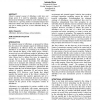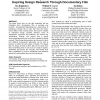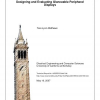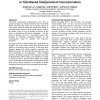ACMDIS
2006
ACM
13 years 10 months ago
2006
ACM
Gibson’s seminal concept of affordance could have real design power if it could be adequately explained as a phenomenon that happens within the scale of human lifetime. Today th...
ACMDIS
2006
ACM
13 years 10 months ago
2006
ACM
By considering the spatial character of sensor-based interactive systems, this paper investigates how discussions of seams and seamlessness in ubiquitous computing neglect the com...
ACMDIS
2006
ACM
13 years 10 months ago
2006
ACM
This paper shows how we can take inspiration and use techniques from documentary film in pursuing user research. Documentary filmmaking has a long history of portraying everyday l...
ACMDIS
2006
ACM
13 years 10 months ago
2006
ACM
Conceptual design dominates the early stages of most creative design processes. During these stages, the designer makes important decisions about the parameters of a model that ar...
ACMDIS
2006
ACM
13 years 10 months ago
2006
ACM
Think-aloud testing is a widely employed usability evaluation method, yet its use in practice is rarely studied. We report an explorative study of 14 think-aloud sessions, the aud...
ACMDIS
2006
ACM
13 years 10 months ago
2006
ACM
ACMDIS
2006
ACM
13 years 10 months ago
2006
ACM
Designers generally agree that understanding the context of use is important in designing products. However, technologically advanced products such as personal robots engender com...
ACMDIS
2006
ACM
13 years 10 months ago
2006
ACM
ACMDIS
2006
ACM
13 years 10 months ago
2006
ACM
Studies which I carried out recently of users of digital music players revealed that the element of randomness plays a role in influencing the user experience (UX). Apart from bei...
ACMDIS
2006
ACM
13 years 10 months ago
2006
ACM
Text-based interpersonal communication tools such as instant messenger are widely used today. These tools often feature emoticons that people use to express emotion to some degree...





